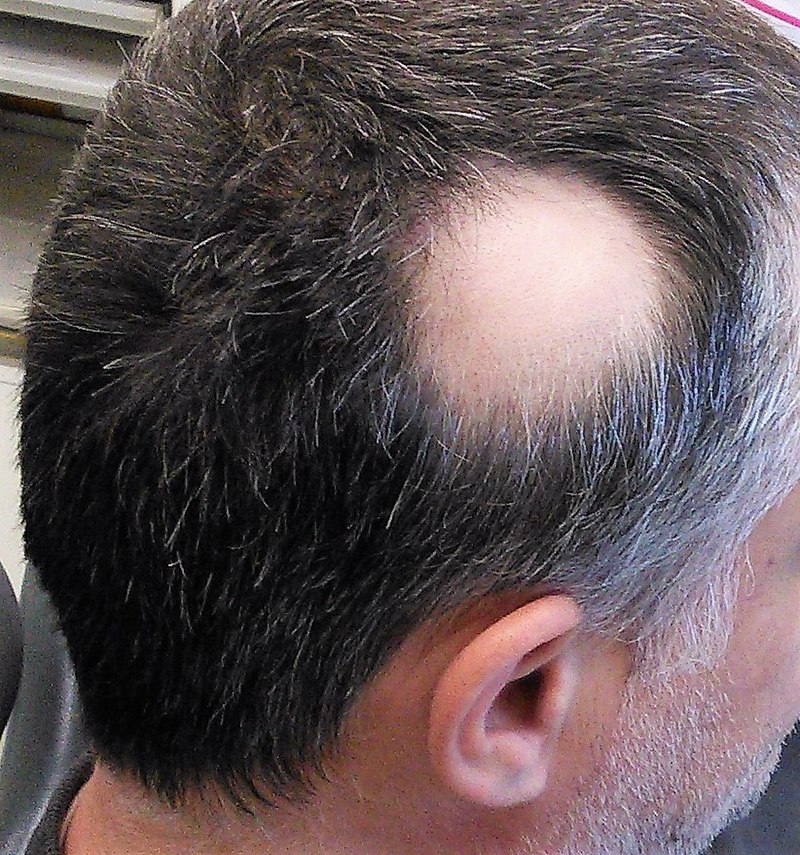Playlist
Show Playlist
Hide Playlist
Alopecia Areata (AA)
-
Slides Dermatology Inflammatory Skin Diseases.pdf
-
Download Lecture Overview
00:01 Our topic here is alopecia areata. 00:04 What does alopecia mean to you? It means loss of hair, period. 00:08 Now, specifically, this alopecia areata is -- well, could be most likely associated with autoimmune disease or the cause is autoimmune. 00:19 The reason I say that is whenever you have one autoimmune disease, it’s very possible that you have others, including maybe something like Hashimoto thyroid disease, With alopecia areata, we have a non-scarring alopecia type. 00:33 So here, you take a look at the head of this individual, and the scalp specifically. 00:37 You’ll notice that we have hair that’s being lost. 00:40 Patches of loss on the scalp, or maybe perhaps, the beard. 00:44 Then sometimes causes loss of all hair on scalp. 00:48 We call this alopecia totalis. 00:52 And all hair on body, and therefore, we call this alopecia universalis, as the name implies. 01:00 In general, alopecia means loss of hair. 01:02 Here, specifically, areata. 01:05 Think of autoimmune disease, please. 01:08 And remember, this is a non-scarring type of alopecia. 01:13 Management: maybe perhaps, topical steroids, maybe intralesional type of steroids, oral steroids, or light treatment. 01:22 Overall, steroid is something that you want to keep in mind when dealing with autoimmune diseases. 01:27 The pathology: the hair bulb was attacked by the lymphocytes, as you can imagine, if we’re referring to autoimmune disease. 01:35 Differential diagnoses: As we have continued now the theme of not only your diseases but the differentials. 01:42 If it’s tinea capitis, what does that mean to you? It’s a fungal infection versus autoimmune disease. 01:47 And the reason that we have capitis is because well, here, it might be a fungal infection of the scalp. 01:53 And of course, this type of fungal infection, what am I referring to? Superficial, or are we dealing with systemic? Superficial Good. 02:00 Tinea capitis, we’ll talk about the organism soon enough called Trichophyton rubrum, as we shall take a look at. 02:09 Here, causes erythema, scaling, and bogginess, things that you normally would not find with alopecia areata. 02:15 Remember, this is more or less a fungal infection. 02:18 So therefore, there might be positive occipital lymphadenopathy, which might be noted with tinea capitis, which is not present with alopecia areata. 02:28 The KOH examination, as you can imagine with tineas, would demonstrate your fungal organism, which obviously has no relevance with alopecia areata. 02:37 And with this differential, you can clearly see that tinea capitis is something that will be easy to identify. 02:44 Another differential will be cutaneous lupus erythematosus. 02:48 When we talk about SLE, we’ll then divide in dermatology our erythematosus into a few different components. 02:55 Specifically, cutaneous, it’s more inflammatory with distinctive pigmentary changes. 03:01 A differential for what are we doing right now? Alopecia areata. 03:05 Cutaneous lupus creates scarring and permanent alopecia. 03:09 The only thing that you have in common between these two conditions is the alopecia. 03:14 However, you don’t have scarring with areata, and with lupus, scarring is much more prevalent. 03:25 Here’s one we haven’t discussed as of yet. 03:27 We have hair loss that’s taking place, perhaps, on the head. 03:30 We have a condition called trichotillomania. 03:33 Have fun saying that. 03:34 It’s fun, rubber baby buggy bumpers, trichotillomania. 03:38 Non-scarring loss. 03:39 So far, the only common denominator between trichotillomania and alopecia areata is the non-scarring, okay? But in trichotillomania, what’s happening? You’re plucking your hair. 03:50 You’ve seen those individuals. 03:52 In terms of IQ, well, IQ has nothing to do with plucking your hair, but maybe perhaps, this individual feels great comfort or maybe perhaps even finds peace with plucking his or her hair. 04:04 Most common in young girls with coexisting psychiatric disturbances. 04:09 Characterized by wide variation in length of the retaining hair depending as to how much you’re plucking out.
About the Lecture
The lecture Alopecia Areata (AA) by Carlo Raj, MD is from the course Inflammatory Skin Diseases.
Included Quiz Questions
What is the complete loss of hair on the scalp (with no scarring) called?
- Alopecia totalis
- Alopecia universalis
- Alopecia areata
- Trichotillomania
- Tinea capitis
A 26-year-old woman presents to your clinic with concerns about scaling lesions on her scalp. KOH examination shows numerous septate, branching hyphae. What is the diagnosis?
- Tinea capitis
- Trichotillomania
- Alopecia areata
- Alopecia totalis
- Alopecia universalis
What is the most likely diagnosis in a patient with variation in the length of their hair within patchy areas of scalp hair loss, who is also experiencing anxiety due to recent severe social stressors?
- Trichotillomania
- Tinea capitis
- Alopecia universalis
- Alopecia areata
- Systemic lupus erythematosus
Customer reviews
4,0 of 5 stars
| 5 Stars |
|
0 |
| 4 Stars |
|
1 |
| 3 Stars |
|
0 |
| 2 Stars |
|
0 |
| 1 Star |
|
0 |
BECAUSE DR CARLO RAJ IS SUCCESSFUL IN MAKING ME UNDERSTAND THE TOPIC. SENTENCES HE USED WERE NOT SO COMPLICATED AND IS SOMEWHAT EASY TO UNDERSTOOD.




